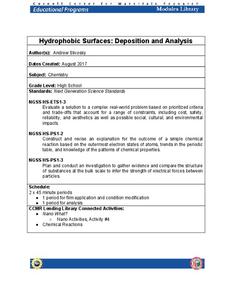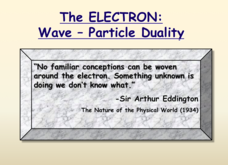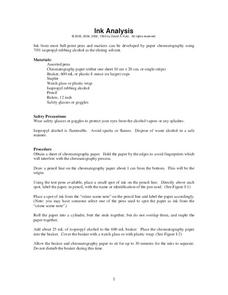Curated OER
The Three E's - Exciting Energetic Electrons
Students perform flame tests on salts and record the electron configurations for various cations. They analyze and record the results using spectroscopes.
Curated OER
The Elements
Fifth graders explore the differences between elements. In this elements and atoms lesson students complete an activity that shows how chemicals react to a flame test.
Curated OER
Reading Vocabulary Definition Test Week 3
In this reading vocabulary test worksheet, students identify the 7 daily terms their instructor defines. Students also write 4 sentences that include the 4 specified vocabulary words.
Curated OER
Combustion In a Test Tube
Students investigate a combustion reaction. In this combustion lesson plan, students mix dry yeast with hydrogen peroxide in a test tube. They place a glowing splint in the test tube and observe the combustion reaction as the splint...
Curated OER
Producing and Testing for Gases
For this gases worksheet, students conduct an experiment to produce 2 different gases and use standard tests to identify each gas. This worksheet has 14 short answer questions.
Curated OER
Testing for Chemicals in Soils
Students use sight, touch and chemical test kits to evaluate and classify soil types. They determine the organic content, soil pH, conduct visual analysis and nutrient tests of a variety of soil samples from various sources.
Cornell University
Hydrophobic Surfaces—Deposition and Analysis
Couches, carpets, and even computer keyboards now advertise they are spill-resistant, but what does that mean? Scholars use physical and chemical methods to coat surfaces with thin films to test their hydrophobic properties. Then they...
Curated OER
Reading Comprehension 3 (Level 7)
Have you ever been in a hot air balloon? Whether your readers are English language learners or native speakers, assess their reading comprehension with this short passage and the seven multiple-choice questions that follow. A detailed...
Chymist
Ink Analysis: An Experiment in Paper Chromatography
Test differences in writing instruments with this hands-on activity to demonstrate paper chromatography in action. The class performs an experiment on multiple writing instruments and determines the area of separation to discover an...
Curated OER
Chemical Sleuthing
Students engage in a lesson which includes flame tests and the construction of a simple diffraction spectrograph with which to measure sodium ion emissions. They use the Bragg equation to compute the wavelength of the line spectra produced.
Curated OER
Flambe Elements
Eighth graders discuss atoms and electrons as well as atoic structure. They view atomic structure via the computer. Students watch a demonstration in which the teacher demonstrates glass tubing turning yellow in a Bunsen Burner flame....
Curated OER
Colored H2 Balloon Explosions
Students perform an experiment in which they put different types of salts in a balloon, fill it with hydrogen gas, and ignite it. The electrons in the salt molecules are excited by the heat and release energy in the form of light. ...
Cornell University
What Happens When We Excite Atoms and Molecules?
Excited atoms lead to exciting lessons! Learners use heat and light to excite both atoms and molecules. They display their learning in the form of Bohr models depicting the excited state of the atoms.
Science Geek
The Dual Nature of the Electron
Why don't atoms collapse? Scientists debated this concept for years before they understood the dual nature of the electron. Presentation discusses the electron as both a particle and an energy wave. It also relates these concepts to the...
Royal Society of Chemistry
Hydroxide Precipitates
When two liquids combine and a solid forms, the new substance is called a precipitate. Scholars test their knowledge of hydroxide precipitates and their properties. A series of four increasingly difficult puzzles challenge their logic...
It's About Time
Identifying Matter
High schoolers test wood splints that have been soaked in mystery solutions to identify the different colors it produces when lit. The lesson concludes with a reading passage and analysis questions.
Curated OER
Bacteria Lab II: Effect of Bacteriocides
Written to follow "Bacteria Lab I: Preparing Agar Plates and Culturing Bacteria," also found via the Lesson Planet site, this lab sheet instructs your microbiologists to test a bacteriocide for effectiveness. In the preceding lab, they...
Pingry School
Qualitative Analysis of Eleven Household Chemicals
Chemical and physical properties give compounds an identity. Learners use the identity of a compound to predict what it is. By performing different tests like solubility, flame, heat, and reactions, individuals attempt to identify an...
Curated OER
Ink Analysis
High school chemistry class members become "detectives for a day" and use the concept of paper chromatography to analyze a note left at the scene of a crime. Pupils test the ink on the note with a solvent, such as isopropyl alcohol, to...
American Chemical Society
The Energy Efficiency of Heating Water
Can a small change in laboratory procedures save energy? Scholars test three different methods for heating water in a science lab. Then, they calculate the energy efficiency for each and compare them to determine which uses the least...
Nuffield Foundation
How Much Energy Is There in Food?
People associate calories with food, but what is a calorie? Young scientists measure the number of calories in samples of food to better understand the concept. They test a variety of samples, take measurements, and compare their results...
Curated OER
You Light Up My Life: Developing a Scientific Theory for What Fuels a Candle's Flame!
Students examine how candles work and how scientific theories are developed and tested. Students propose hypotheses about what is burning in a candle then perform tests in order to develop their scientific theory. After a teacher...
Curated OER
CO2 and Air Pollution
Seventh graders observe and test for the presence of carbon dioxide gas. They compare concentrations of carbon dioxide gas and conclude high concentrations of carbon dioxide gas are unhealthy for human beings.
Curated OER
A Burst of Light
Students discover the many uses of minerals in industry. They use minerals to conduct flame tests and to demostrate color. They practice safety tips in the lab.
Other popular searches
- Flame Test Lab
- Flame Test of Elements
- Light Flame Test
- Chemistry Flame Test
- Flame Test for Ions
- Spectroscopy Flame Test
- Chlorides Flame Test
- Flame Tests Chemistry
- Science Flame Tests
- Flame Tests Fireworks
- Element Flame Tests
- Flame Test Compounds

























